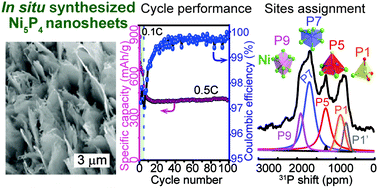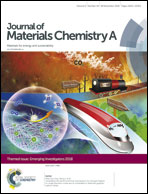In situ synthesis and in operando NMR studies of a high-performance Ni5P4-nanosheet anode†
Abstract
Nickel phosphide (Ni5P4) nanosheets are synthesized using in situ chemical vapor deposition of P on Ni foam. The thickness of the as-synthesized Ni5P4 film is determined to be ∼5 nm, using atomic force microscopy (AFM). The small thickness shortens the diffusion path of Li ions and results in fast ion transport. In addition, the 2D Ni5P4 nanosheets seamlessly connect to the Ni foam, which facilitates electron transfer between Ni5P4 and the Ni current collector. Therefore, the binder/carbon free-nickel supported Ni5P4 shows fast rate performance as an anode for lithium-ion batteries (LIBs). The specific capacity of 2D Ni5P4 is obtained as 600 mA h g−1 at a cycling rate of 0.1C, approaching the theoretical capacity of 768 mA h g−1. Even at a rate of 0.5C, the capacity remains as 450 mA h g−1 over 100 cycles. A capacity >100 mA h g−1 is retained at a very high rate of 20C. Ni5P4 also exhibits a low voltage of ∼0.5 V with respect to Li metal, which makes it a suitable negative electrode for LIBs. In operando31P NMR and 7Li NMR are employed to probe the lithiation and de-lithiation mechanisms upon electrochemical cycling.

- This article is part of the themed collection: Journal of Materials Chemistry A Emerging Investigators


 Please wait while we load your content...
Please wait while we load your content...
